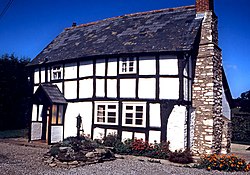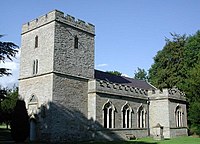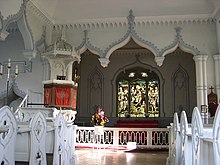Shobdon
| Shobdon | |
| Herefordshire | |
|---|---|

| |
| Location | |
| Grid reference: | SO398618 |
| Location: | 52°15’5"N, 2°52’57"W |
| Data | |
| Population: | 816 |
| Post town: | Leominster |
| Postcode: | HR6 |
| Dialling code: | 01568 |
| Local Government | |
| Council: | Herefordshire |
| Parliamentary constituency: |
North Herefordshire |
Shobdon is a small village in Herefordshire, sitting 15 miles north of Hereford and six miles west of Leominster, or two miles south-west of the Mortimer's Cross.
The 2001 Census recorded a parish population of 769, which had increased to 816 by the time of the 2011 Census.
Parish church

Shobdon’s parish church, St John The Evangelist, is a remarkable building for its internal decoration: a Georgian rococco church.[1]
The first known church at Shobdon was a timber chapel, built in the Anglo-Saxon period. The second was a stone church built in the 12th century, builrt at the direction of Oliver de Merlemond. A tower was added in the 13th century.

The third and present church consisted of a completely new nave, which was built onto the 13th century tower, by the Bateman family in 1756.
The current church has a bland exterior which gives little clue to the splendours inside, which are a unique combination of Rococo and Gothic, often called ‘Strawberry Hill Gothick’, which reflects the school of design from which it came: the Batemans who built the name had links to Horace Walpole and his aesthetic. The result is considered a hugely important work of architecture.[2][3]
The church has a direct connection to Horace Walpole’s Strawberry Hill in Twickenham and the members of the Committee of Taste which strongly influenced its design. This interior and its matching furniture are the sole example of this Walpolean Gothick style of Georgian church architecture and furnishing.
The Shobdon Church Preservation Trust was founded to protecting the fabric of this building of national importance for future generations.[2] The Trust is a registered charity.[4]
Simon Jenkins has commented:
Nothing quite prepares the visitor for Shobdon…. a complete masterpiece, English Rococo executed with confidence at a time when new churches in the Gothick style were rare.—Simon Jenkins – England’s Thousand Best Churches
The interior is striking in blue and white interior, with a wealth of ornamental arches, a lavish pulpit, based on a design prepared for York Minster, and extensive Gothic detailing.
The original interior arches of the church, removed in 1756, were placed at the top of the adjacent hill as a folly where they still stand. The Shobdon Arches consist of a central chancel arch and two Norman doorways. The fine, though weathered, carvings are the work of the Herefordshire School of sculpture, which dominated in the western counties during the mid 12th Century.
History
In the 17th century the village of Shobdon was run by the Bateman family (whose name is remembered in the local pub, the Bateman Arms). They lived at Shobdon Court.
It was the Bateman family who created the parish church in its current form, and in the process created from the nave of the old church the folly on the hill known as the Shobdon Arches.[5]
About the village
The village has a primary school. Co-located with the Primary School is Shobdon Village Hall. Occasional fundraising activities are undertaken by the village hall committee.
At the western end of the village is Pearl Lake caravan park, adjacent to Pearl Lake, the largest natural body of water in Herefordshire.
To the south is situated Shobdon Aerodrome, formerly a Royal Air Force glider training facility operational during the Second World War, now used for commercial and recreational helicopter flying[6] fixed wing power flying [7] and glider flying.[8] Shobdon Aerodrome was constructed in 1942. In operation it was only used as a glider training base. Pilots who trained here took part in both the Normandy landings and Operation Market Garden at Arnhem in the Netherlands.
Shobdon Festival
The annual Shobdon Festival began as a church flower festiva held every three years. This was expanded into an annual food, drink, flower and flying festival which is held on the last weekend in June.[9]
Outside links
| ("Wikimedia Commons" has material about Shobdon) |
- http://www.shobdongliding.co.uk/ Shobddon Gliding]
- The Shobdon Church Preservation Trust
- Shobdon Food and Flying Festival
References
- ↑ The Arrowdale Churches
- ↑ 2.0 2.1 The Shobdon Church Preservation Trust
- ↑ Ross, David. "Shobdon, St John Church". Britain Express. http://www.britainexpress.com/attractions.htm?attraction=3870. Retrieved 6 May 2016.
- ↑ The Shobdon Church Preservation Trust - Registered Charity no. 1100957 at the Charity Commission
- ↑ The Arches - Shobdon Church Preservation Trust
- ↑ http://www.tigerhelicopters.co.uk
- ↑ http://www.herefordshireaeroclub.com
- ↑ http://www.shobdongliding.co.uk
- ↑ Shobdon Food and Flying Festival
